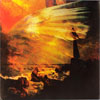 A couple of years ago, when Justin Broadrick decided to sing instead of shout and focus more on atmospheres instead of riffing, Godflesh became Jesu and an entirely new genre ("shoegaze metal" perhaps) was born. The Angelic Process have been quick to put their mark on the genre, and this disc is a good effort that is unfortunately hindered by spotty production.
A couple of years ago, when Justin Broadrick decided to sing instead of shout and focus more on atmospheres instead of riffing, Godflesh became Jesu and an entirely new genre ("shoegaze metal" perhaps) was born. The Angelic Process have been quick to put their mark on the genre, and this disc is a good effort that is unfortunately hindered by spotty production.
The duo of K. Angylus (guitar, vocals, drums and electronics) and M. Dragynfly (bass, vocals and electronics) follow along in the Jesu style of thick, slow atmospheres (probably just as inspired by The Cure's Faith as Broadrick himself) though their approach emphasizes the electronics and synths more than just the guitars. The vocals are consistent with the rest of the style: mostly singing and occasionally shouted but always so deep in the mix to be nearly unintelligible. From what can be discerned, the vocals by Dragynfly occasionally resemble a slightly more histrionic Susan Steinger, which is not a bad thing.
Opening track "The Promise of Snakes," clocking in at nearly 10 minutes, is one of the highlights of the album: opening with dark atmospheric synth and a metronomic drum machine rhythm, the track soon blasts open with thick vocals and guitar riffing before picking up the tempo to a nearly metal pace. Though long, the track shifts in tempos and dynamics enough to never become stagnant. "The Resonance of Goodbye" begins similarly, but the distortion is at such a level that it almost resembles a noise band more than anyone playing guitar. That is, until the vaguely prog-rock guitar solo makes an appearance.
"We All Die Laughing" is one of the few tracks that focuses a bit less on the ambience and a little more on the riffs: heavily monolith ones that, if it were not for the muddy distortion wouldn't be out of place on an early Swans record. "Dying in A-Minor" is instead more focused on the electronic elements of The Angelic Process' sound, but digital clipping unfortunately hampers the more gentle passages.
Which brings me to my biggest gripe about this album: the production. There are a lot of interesting moments on the disc but most of them are hampered by a mix that is based on heavy, mid-range distortion that unfortunately blurs everything else. Nothing is distinct and this distortion is pretty much identical from track to track, leaving, superficially at least, very little variation. Close listening shows that there is a lot of diversity from one song to another, but on the surface it all sounds the same. Plus, there is too much reverb. (This is coming from someone who subscribes to the Lee Perry/Martin Hannett "mo' reverb is mo' better" school of thought.) Perhaps it was an attempt to sound "kvlt" like so many black metal bands, but in actuality it makes what could have been a great album just a good one.
samples:
Read More

